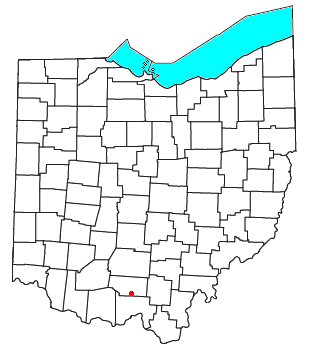
Mason County is a county located in the U.S. state of Kentucky. Its county seat is Maysville. The county was created from Bourbon County, Virginia in 1788 and named for George Mason, a Virginia delegate to the U.S. Constitutional Convention known as the "Father of the Bill of Rights". Mason County comprises the Maysville, KY Micropolitan Statistical Area, which is included in the Cincinnati-Wilmington-Maysville, OH-KY-IN Combined Statistical Area.

Maysville is a town in Banks and Jackson counties in the U.S. state of Georgia. The population was 1,798 at the 2010 census, up from 1,247 at the 2000 census.

Brooksville is a home rule-class city in Bracken County, Kentucky, in the United States. As of the 2010 census, the city's population was 642. It is the county seat of Bracken County.

DeTour Village is a village in Chippewa County in the U.S. state of Michigan. The population was 325 at the 2010 census.

A number of pre-Columbian cultures in North America were collectively termed "Mound Builders", but the term has no formal meaning. It does not refer to a specific people or archaeological culture, but refers to the characteristic mound earthworks which indigenous peoples erected for an extended period of more than 5,000 years. The "Mound Builder" cultures span the period of roughly 3500 BCE to the 16th century CE, including the Archaic period, Woodland period, and Mississippian period. Geographically, the cultures were present in the region of the Great Lakes, the Ohio River Valley, and the Mississippi River valley and its tributary waters.

The Criel Mound, also known as the South Charleston Mound, is a Native American burial mound located in South Charleston, West Virginia. It is one of the few surviving mounds of the Kanawha Valley Mounds that were probably built in the Woodland period after 500 B.C. The mound was built by the Adena culture, probably around 250–150 BC, and lay equidistant between two “sacred circles”, earthwork enclosures each 556 feet (169 m) in diameter. It was originally 33 feet (10 m) high and 173 feet (53 m) in diameter at the base, making it the second-largest such burial mound in the state of West Virginia. This archaeological site is listed on the National Register of Historic Places.
Institute is an unincorporated community on the Kanawha River in Kanawha County, West Virginia, United States. Interstate 64 and West Virginia Route 25 pass by the community, which has grown to intermingle with nearby Dunbar. As of 2018, the community had a population of 1,489, 54% of whom were African American.

The William H. Harsha bridge is a cable-stayed bridge carrying U.S. Route 62 and U.S. Route 68 that connects Maysville, Kentucky, and Aberdeen, Ohio, over the Ohio River. It is named for William Harsha, who represented the Ohio portion of the area in the United States House of Representatives. Construction on the bridge started in 1997 and it opened in 2000. The bridge has a main span of 1,050 feet and a total span of 2,100 feet (640 m). The Simon Kenton Bridge, a suspension bridge built in 1932, is located nearby.

Wakefield is an unincorporated community in southwestern Scioto Township, Pike County, Ohio, United States. it historically had a post office, with the ZIP code 45687. Although the post office was closed on September 2, 2005, the community retains its ZIP code. It lies along Wakefield Mound Road.
The Bat Creek inscription is an inscribed stone tablet found by John W. Emmert on February 14, 1889. Emmert claimed to have found the tablet in Tipton Mound 3 during an excavation of Hopewell mounds in Loudon County, Tennessee. This excavation was part of a larger series of excavations that aimed to clarify the controversy regarding who is responsible for building the various mounds found in the Eastern United States.

Rock Eagle Effigy Mound is an archaeological site in Putnam County, Georgia, U.S. estimated to have been constructed c. 1000 BC to AD 1000. The earthwork was built up of thousands of pieces of quartzite laid in the mounded shape of a large bird. Although it is most often referred to as an eagle, scholars do not know exactly what type of bird the original builders intended to portray. It is listed on the National Register of Historic Places (NRHP) because of its significance. The University of Georgia administers the site. It uses much of the adjoining land for a 4-H camp, with cottages and other buildings, and day and residential environmental education.
Rock Hawk Effigy Mound is an archaeological site in Putnam County, Georgia, United States. It consists of thousands of pieces of quartzite laid in the shape of a large bird. Although it is most often referred to as a hawk, scholars do not know exactly what type of bird the original builders intended to portray.
Maysville is an unincorporated community in Washington Township, Daviess County, Indiana.
The Oak Mounds is a large prehistoric earthwork mound, and a smaller mound to the west. They are located outside Clarksburg, in Harrison County, West Virginia.
Sudley Springs is an unincorporated community in Prince William County, in the U.S. state of Virginia.
Grimsleyville is an unincorporated community in Buchanan County, Virginia, in the United States.

Maysville is an unincorporated community in Allen and Hardin counties, in the U.S. state of Ohio.
Wahlsburg is an unincorporated community in Brown County, in the U.S. state of Ohio.
Taft is an unincorporated community in Butler County, in the U.S. state of Missouri.
Mabee Corner is an unincorporated community in Hamilton Township, Jackson County, Ohio, United States. It is located west of Oak Hill at the intersection of Bucklick Creek Road and Ohio State Route 139, at 38°54′10″N82°43′16″W.











